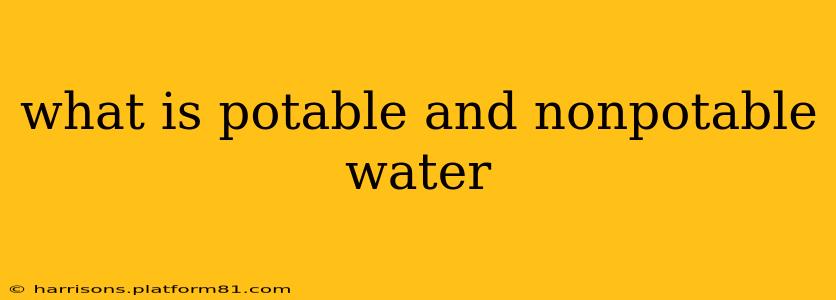Understanding the difference between potable and non-potable water is crucial for health and safety. While the terms might seem straightforward, the nuances can be surprisingly complex. This guide will clarify the definitions, explore the distinctions, and answer common questions surrounding these crucial water classifications.
What is Potable Water?
Potable water, also known as drinking water, is water that is safe for human consumption. This means it's free from harmful bacteria, viruses, parasites, and chemicals that could cause illness. The safety standards for potable water vary slightly depending on location (country, state, or even municipality), but generally involve rigorous testing and treatment processes to meet specific guidelines. These guidelines often cover parameters like:
- Biological Contaminants: Bacteria (e.g., E. coli), viruses, and parasites.
- Chemical Contaminants: Heavy metals (lead, arsenic), pesticides, herbicides, industrial chemicals.
- Physical Contaminants: Turbidity (cloudiness), sediment, and excessive minerals.
- pH levels: Ensuring the water isn't excessively acidic or alkaline.
What is Non-Potable Water?
Non-potable water, conversely, is water that is not safe for drinking or other purposes requiring purified water. This water may contain harmful substances at levels exceeding safety standards. Sources of non-potable water include:
- Surface Water: Rivers, lakes, and streams often contain pollutants and microorganisms.
- Groundwater: While naturally filtered, groundwater can be contaminated by various sources.
- Reclaimed Water: Water that has been treated for reuse, but not to drinking water standards. This is often used for irrigation or industrial purposes.
- Untreated Water: Water directly from a source without any purification.
What are the Differences Between Potable and Non-Potable Water?
The key difference lies in safety for human consumption. Potable water undergoes treatment to remove or reduce harmful contaminants to meet stringent health standards. Non-potable water either hasn't been treated or hasn't been treated sufficiently to guarantee safety for human consumption. Using non-potable water for drinking or cooking can lead to serious health problems.
How is Potable Water Made?
The process of making potable water often involves several stages:
- Source Water Selection: Identifying a clean and reliable source.
- Coagulation and Flocculation: Adding chemicals to clump together suspended particles.
- Sedimentation: Allowing the heavier particles to settle out.
- Filtration: Removing remaining particles through various filter types (sand, gravel, carbon).
- Disinfection: Killing harmful bacteria and viruses (usually with chlorine, chloramine, ozone, or UV light).
Can Non-Potable Water Be Made Potable?
Yes, many non-potable water sources can be treated to become potable. The treatment process depends on the nature and level of contamination. This might involve filtration, disinfection, chemical treatment, or a combination of methods. However, some contaminants are extremely difficult or impossible to remove, rendering the water permanently unsuitable for consumption.
What Happens if You Drink Non-Potable Water?
Drinking non-potable water can result in a range of illnesses, from mild gastrointestinal issues (diarrhea, vomiting) to severe infections and long-term health problems. The severity of the consequences depends on the type and amount of contaminants ingested.
How Can You Tell if Water is Potable?
You cannot reliably determine if water is potable simply by looking at it. It's crucial to rely on certified testing and public health advisories. If you are unsure about the safety of a water source, err on the side of caution and assume it's non-potable.
What are the uses of non-potable water?
Non-potable water has numerous uses, including:
- Irrigation: Watering plants and crops.
- Industrial Processes: Cooling systems, manufacturing.
- Toilet Flushing: Conserving potable water.
- Fire Suppression: In some situations.
This comprehensive guide offers a clear understanding of potable and non-potable water, emphasizing the importance of distinguishing between the two for health and safety. Remember, when in doubt, always prioritize potable water sources for drinking and food preparation.
